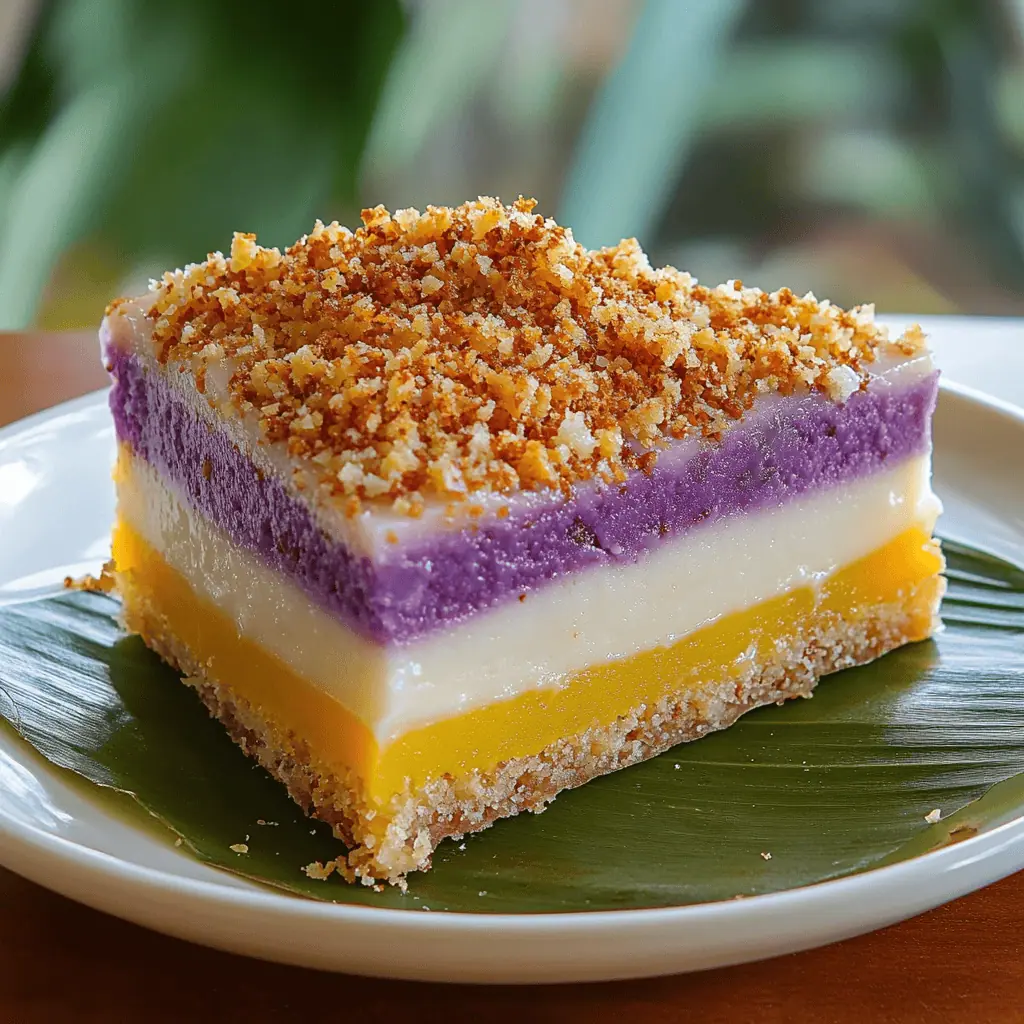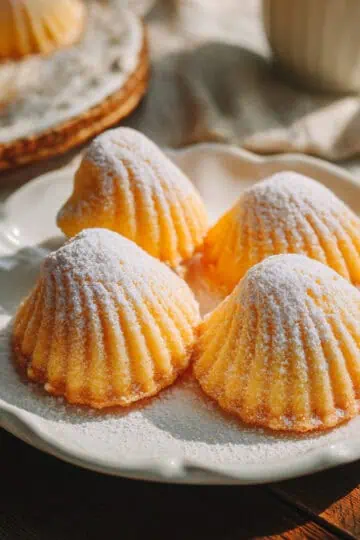Sapin-Sapin was my ultimate merienda weakness. Every afternoon at around 3 PM, I'd hear the familiar "Bilao! Kakanin!" call from Aling Yolly, our neighborhood magkakanin. My mother would often buy this colorful treat, and I'd rush downstairs with my coin purse, excited to see those perfectly layered purple, yellow, and white squares topped with golden latik.
There was something magical about how each chewy layer offered a different flavor: from sweet ube to tropical langka to creamy coconut. Now that I'm making it in my own kitchen, I've discovered that this childhood favorite isn't as complicated as it looks.
With just a few key ingredients and some patience, you can recreate this classic Filipino sapin-sapin recipe that's perfect for your family's merienda time or your next potluck celebration. Once you master this recipe, you'll never have to wait for the magkakanin to pass by again.
What is Sapin-Sapin?
Sapin-Sapin is a traditional Filipino layered rice cake made with glutinous rice flour, coconut milk, and condensed milk. Its signature triple-decker appearance features purple ube (purple yam), yellow jackfruit, and white coconut layers, each distinctly flavored and steamed to chewy perfection. Crowned with crispy latik (caramelized coconut curds), this beloved merienda (snack) balances sweet richness with textural complexity.
Jump to:

Why You'll Love This Recipe
- ✨ Instagram-worthy presentation with vibrant layers
- 🏆 Authentic Filipino flavors passed down through generations
- 💝 Perfect for special occasions and gatherings
- 🎨 Customizable colors and flavors
- 👩🍳 Detailed steps make this seemingly complex dessert achievable
- 🌟 Premium ingredients create restaurant-quality results
Ingredients
These ingredients create the perfect balance of flavors and textures that make Sapin-Sapin so beloved. Glutinous rice flour provides that signature chewy, sticky texture Filipinos adore in kakanin.
Coconut milk and condensed milk work together to create rich, creamy layers with just the right sweetness. The ube and jackfruit extracts add vibrant colors and distinct Filipino flavors that represent our tropical heritage.
Finally, the latik topping adds a delicious contrasting crunch that elevates this dessert from simple to spectacular.

For the Layers:
- 3½ cups glutinous rice flour
- 2 cans (13.5 oz each) coconut milk
- 1 can (14 oz) condensed milk
- 1 cup sugar
- 3 drops ube extract
- 3 drops jackfruit extract
For the Latik Topping:
- 1 cup coconut cream
Equipment
- Large steamer (Kaldero at Pangsteam): Essential for properly cooking each layer to the perfect consistency
- 8-inch round pan or 8x8 square pan: Creates the ideal shape and thickness for traditional sapin-sapin
- Fine-mesh strainer (salaan): Ensures a smooth, lump-free batter for silky texture
- Rubber spatula (Pangkayod): Perfect for gentle mixing and scraping every bit of batter
- Measuring cups and spoons (Panukat): Provides precise measurements for consistent results
- Large mixing bowls: Necessary for preparing the different colored batters separately
- Kitchen brush: Used for applying coconut oil coating to prevent sticking

How To Make
- Prepare the pan and latik: Grease an 8-inch round or square pan with coconut oil and set aside. Make the latik by pouring 1 cup coconut cream into a pan and cooking over medium heat while stirring continuously for 15-20 minutes until it turns golden brown and forms curds. Remove from heat and set aside.
- Create the batter base: In a large bowl, combine 3½ cups glutinous rice flour, 2 cans coconut milk, 1 can condensed milk, and 1 cup sugar. Mix thoroughly until completely smooth and free of lumps. Strain the mixture through a fine-mesh strainer to ensure a silky consistency.
- Divide and color the batter: Split the batter equally into three portions in separate bowls. Add 3 drops of ube extract to the first portion and mix well. Add 3 drops of jackfruit extract to the second portion and mix thoroughly. Leave the third portion plain white.
- Steam the first layer: Prepare your steamer with water and bring to a boil. Pour the purple ube mixture into the prepared pan and steam for 10 minutes or until set. Test for doneness with a toothpick - it should come out clean.
- Add the second layer: Gently pour the yellow jackfruit mixture over the purple layer and steam for another 10 minutes until set. Ensure the first layer is slightly warm before adding the second to prevent separation.
- Complete with the third layer: Finally, pour the white coconut mixture over the yellow layer and steam for a final 10 minutes until completely cooked. Once done, remove from the steamer and let cool slightly.
- Finish and serve: While still warm, top the sapin-sapin with the prepared golden latik. Allow to cool completely at room temperature before cutting into squares or diamond shapes.

Tips from Lola's Kitchen
- Room temperature ingredients create a smoother batter and prevent lumps
- Reduce heat to medium once the water in the steamer begins to boil
- Test each layer with a toothpick before adding the next one
- Don't rush the cooling process to prevent condensation that can make the top soggy
- Brush coconut oil between layers if you're concerned about separation
- For best results, use freshly squeezed coconut milk if available
- Tap the pan gently after pouring each layer to remove air bubbles
- Cover the steamer with a cloth before placing the lid to prevent water droplets from falling on the sapin-sapin
Substitutions
- Glutinous rice flour: You can use regular rice flour in a pinch, but the texture will be less chewy and more cake-like
- Coconut milk: Evaporated milk with coconut extract can work, though the flavor won't be as authentic
- Ube extract: Substitute with ¼ cup mashed purple yam (prepared ube halaya works too)
- Jackfruit extract: Pandan extract creates a beautiful green layer with a different but complementary flavor
- Sugar: Coconut sugar can be used for a more caramel-like flavor profile
- Latik: Toasted coconut flakes can be used as a quicker alternative topping
Troubleshooting
Layers separating?
- Ensure each layer is still slightly warm (not completely cooled) before adding the next
- Lightly score the surface of each layer with a fork before adding the next one
- Make sure all batters have the same consistency
Batter too thick?
- Add coconut milk one tablespoon at a time until you reach the desired consistency
- The batter should coat the back of a spoon but still be pourable
Latik burning?
- Lower heat immediately and continue stirring
- Remove any dark pieces quickly before they impart a bitter flavor
- Add a teaspoon of fresh coconut cream to cool the mixture slightly
Sapin-Sapin too soft?
- Steam for an additional 3-5 minutes per layer
- Check if your glutinous rice flour is fresh and properly stored
- Ensure you're using the correct measurements for liquid ingredients
Storage & Reheating
- Room temperature: Can be kept for up to 1 day covered with a clean kitchen towel
- Refrigerated: Store in an airtight container for up to 5 days
- Freezing: Not recommended as it changes the texture significantly
- Reheating: Steam for 3-5 minutes to restore the soft, chewy texture
- Serving after refrigeration: Let it come to room temperature for about 30 minutes before serving

FAQ
What does "Sapin-Sapin" mean?
Sapin-Sapin literally means "layers" in Filipino, referring to the multiple colorful layers of this dessert.
Can I make this in advance for a party?
Yes, you can prepare it 1-2 days ahead and store it in the refrigerator. For best texture, bring to room temperature before serving.
Why did my layers mix together?
Each layer must be firm enough before adding the next. Make sure you're steaming each layer until it passes the toothpick test.
Is Sapin-Sapin gluten-free?
Yes, when made with pure glutinous rice flour, this dessert is naturally gluten-free.
Can I use food coloring instead of natural extracts?
Yes, though you'll miss the flavor components. Add a small amount of food coloring plus ½ teaspoon of complementary flavoring (vanilla, coconut, etc.).
How do I know when the latik is ready?
The coconut cream will first separate, then the solids will begin to brown. Stop when they're golden brown with a nutty aroma.
Can I make mini portions in muffin tins?
Absolutely! Reduce steaming time to about 5-7 minutes per layer for smaller portions.
What's the best way to cut Sapin-Sapin neatly?
Use a knife dipped in hot water and wiped clean between cuts for the cleanest results.
Related
Looking for other recipes like this? Try these:

Sapin-Sapin Recipe (Traditional Filipino Layered Sticky Rice Cake)
Equipment
- Large steamer (Kaldero at Pangsteam) For properly cooking the layers
- 8x2 round pan or 8x8 square pan For molding the perfect shape
- Fine-mesh strainer (salaan) To ensure smooth, lump-free batter
- Rubber spatula (Pangkayod) For gentle mixing and scraping
- Measuring cups and spoons (Panukat) For precise measurements
- Large mixing bowls For preparing different colored batters
- Kitchen brush For applying coconut oil coating
Ingredients
For the Layers:
- 3½ cups glutinous rice flour
- 2 cans 13.5 oz each coconut milk (Gata)
- 1 can 14 oz condensed milk
- 1 cup sugar Asukal
- 3 drops ube extract Katas ng Ube
- 3 drops jackfruit extract Katas ng Langka
For the Latik Topping:
- 1 cup coconut cream Kakang Gata
Instructions
- First grease an 8-inch round or square pan with coconut oil and set aside. Begin by making the latik: Pour 1 cup coconut cream into a pan and cook over medium heat (175°C/350°F) while stirring continuously for 15-20 minutes until it turns golden brown and forms curds (hanggang maging kulay ginto at maging butil-butil). Remove from heat and set aside.
- In a large bowl, combine 3½ cups glutinous rice flour (galapong na malagkit), 2 cans coconut milk (gata), 1 can condensed milk, and 1 cup sugar (asukal). Mix thoroughly until completely smooth and free of lumps (hanggang maging makinis). Strain the mixture through a fine-mesh strainer (salain para walang butil) to ensure a silky consistency.
- Divide the batter equally into three portions in separate bowls. Add 3 drops of ube extract (katas ng ube) to the first portion and mix well. Add 3 drops of jackfruit extract (katas ng langka) to the second portion and mix thoroughly. Leave the third portion plain white.
- Prepare your steamer with water and bring to a boil (100°C/212°F). Pour the purple ube mixture into the prepared pan and steam for 10 minutes or until set (lutong-luto na). Test for doneness with a toothpick - it should come out clean.
- Gently pour the yellow jackfruit mixture over the purple layer and steam for another 10 minutes until set. Ensure the first layer is slightly warm before adding the second to prevent separation (para hindi maghiwalay ang mga layer).
- Finally, pour the white coconut mixture over the yellow layer and steam for a final 10 minutes until completely cooked. Once done, remove from the steamer and let cool slightly.
- While still warm, top the sapin-sapin with the prepared golden latik. Allow to cool completely at room temperature before cutting into squares or diamond shapes (hiwain ng pahaba o dyamante).
Tips from Lola's Kitchen
- Always use room temperature ingredients for smooth mixing
- "Kapag kumulo na ang tubig sa steamer, ibaba ang apoy sa katamtaman" (Once water boils, reduce heat to medium)
- Let each layer set completely before adding the next
- Use banana leaves for lining to add traditional aroma
- Never rush the cooling process to prevent condensation
Nutrition
The Story Behind Sapin-Sapin (Filipino Layered Sticky Rice Cake)
In the bustling streets of Pampanga, known as the Culinary Capital of the Philippines, Sapin-Sapin emerged as a testament to Filipino ingenuity in traditional kakanin (rice cake) making. This vibrant three-layered glutinous rice dessert, whose name literally translates to "layers," represents the Filipino's love for colorful, festive foods that bring communities together.
Dating back to the Spanish colonial period, Sapin-Sapin showcases the abundance of local ingredients that flourished in Philippine soil. The dessert traditionally features native purple yam (ube), tropical jackfruit (langka), and coconut milk (gata), ingredients that have been staples in Filipino cooking for centuries. The crowning glory of crispy latik (caramelized coconut curds) adds a distinctly Filipino touch that transformed this simple rice cake into a sought-after delicacy.
What makes Sapin-Sapin truly special is its evolution from a humble town celebration treat to a beloved everyday merienda (afternoon snack). In traditional Filipino households, the sight of a magkakanin (rice cake vendor) carrying their bilao (bamboo tray) filled with colorful Sapin-Sapin would excite children and adults alike. The dessert's popularity soared as skilled home cooks passed down their secret techniques for achieving those perfectly defined layers and ideal chewy texture.
Today, while modern bakeries and restaurants offer this classic dessert, many Filipino families still prefer the traditional way of making Sapin-Sapin at home. The process of carefully steaming each layer has become a cherished ritual, often accompanied by stories shared between generations. Whether enjoyed during afternoon merienda, brought to family gatherings, or served during fiestas, Sapin-Sapin continues to captivate with its stunning appearance and delightful mix of flavors that speak deeply of Filipino culinary heritage.
From its humble beginnings in provincial kitchens to its current status as a Filipino cultural icon, Sapin-Sapin embodies the artistry, patience, and love for tradition that defines Filipino dessert-making. Each colorful layer tells a story of cultural preservation, family bonds, and the simple joy of sharing something delicious with loved ones.










marlene says
Great recipe. Thank you for sharing it